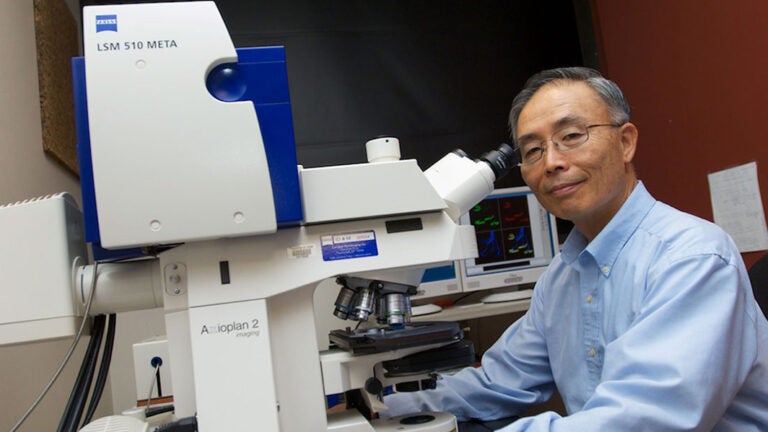
Thanks to this scientist, doctors have another option for treating a leading cause of infant death
His name is Chien-Ping Ko, and he’s a neuroscientist at the USC Dornsife College of Letters, Arts and Sciences. For years, he labored in obscurity in his lab, searching for a solution for spinal muscular atrophy (SMA), a rare and often fatal genetic neurodegenerative disease affecting muscle strength and movement in children. His research proved critical to a new drug, which was recently approved by the U.S. Food and Drug Administration.
Evrysdi (risdiplam), much cheaper and easier to administer than existing options, is only the third therapy — and the first oral drug — approved to treat SMA patients 2 months of age and older, according to the FDA. The disease, which affects 1 in 6,000 to 10,000 babies, is the leading genetic cause of infant death.
For Ko, 72, the achievement marks a fantastic finale for a scientist who will retire next year after four decades at USC Dornsife.
Commitment to research inspires colleagues
Ko downplays his role and credits many collaborators. “It takes a whole village to get to this result,” he said. “I’ve just been fortunate to be in the right place at the right time.”
Nonetheless, his colleagues at USC Dornsife say he played a key role in the preclinical research. He solved the genetic riddle of why muscles and nerve connections fail in some children, which renders them unable to move, swallow or breathe and often leads to death.
“He’s old school and gets the work done in the trenches, pushing and pushing,” said Stephen Bradforth, divisional dean for physical sciences and mathematics at USC Dornsife. “His work is about fundamental science that translated to produce a remedy for childhood disease.”
Said David McKemy, professor of biological sciences and head of the neurobiology section at USC Dornsife: “It’s very rare for a scientist to do so much foundational science and preclinical work with cells and lab animals and genetics and see it through to the end. Few scientists ever achieve this.”
New drug helps SMA patients move, breathe
One day, a family from Kansas that was affected by the disease came to Ko’s lab, and the mother brought one of her two daughters, both of whom suffered from SMA.
“The children were in wheelchairs and they couldn’t move very well. The mother said, ‘If we could help them just comb their hair, that would be a big relief.’ I didn’t even think about such a simple thing, how one minor improvement could make such a big difference,” Ko said.
While the treatment he helped develop is not a cure, it can help SMA patients gain greater mobility. Moreover, it comes in liquid form — the first orally administered drug for SMA.
Look beyond medicine
An immigrant from Taiwan, Ko recalls members of his family having stomach ulcers, which piqued his interest in biology. He studied neuromuscular connections for 40 years and shifted his focus to SMA in the past decade. He came to USC Dornsife for its acclaimed neuroscience program, the opportunity to partner with private enterprise and an emphasis on translational medicine.
As Ko prepares to retire, he looks forward to the impact his students can make.
“I hope my story inspires students to get into science,” he said. “And while this all starts with basic research, it really does take a village of people. Science students need to learn social skills and communications and consider ways they might also use their science skills in other fields, like law, business, government or nonprofit groups. To students, I advise you not to limit yourself to only medicine.”